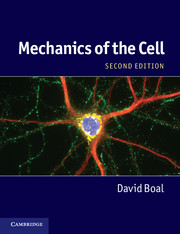Book contents
- Frontmatter
- Contents
- Preface
- List of symbols
- 1 Introduction to the cell
- 2 Soft materials and fluids
- Part I Rods and ropes
- Part II Membranes
- Part III The whole cell
- 10 The simplest cells
- 11 Dynamic filaments
- 12 Growth and division
- 13 Signals and switches
- Appendix A Animal cells and tissues
- Appendix B The cell’s molecular building blocks
- Appendix C Elementary statistical mechanics
- Appendix D Elasticity
- Glossary
- References
- Index
11 - Dynamic filaments
Published online by Cambridge University Press: 05 June 2012
- Frontmatter
- Contents
- Preface
- List of symbols
- 1 Introduction to the cell
- 2 Soft materials and fluids
- Part I Rods and ropes
- Part II Membranes
- Part III The whole cell
- 10 The simplest cells
- 11 Dynamic filaments
- 12 Growth and division
- 13 Signals and switches
- Appendix A Animal cells and tissues
- Appendix B The cell’s molecular building blocks
- Appendix C Elementary statistical mechanics
- Appendix D Elasticity
- Glossary
- References
- Index
Summary
Cells are more than just passive objects responding to external stresses: they can actively change shape or move with respect to their environment. A very familiar example of cellular shape change is the contraction of our muscle cells. Less familiar, but very important to our health, is the locomotion of cells such as macrophages, which work their way through our tissues to capture and remove hostile cells and material. Another example of cell movement is propulsion in a fluid medium, which in some cells is provided by the rotation of flagella (Latin plural for the noun whip) extending from the cell body. Flagella can be seen from several cells of the bacterium Brevundimonas alba in Fig. 11.1. Structurally related to flagellaare cilia(Latin plural for eyelash), which occur on the surfaces of some cells and wave in synchrony like tall grass in the wind, creating currents in their fluid environment. What microscopic mechanisms underlie a cell’s movement or motility?
In Section 11.1, we review several aspects of cell movement and trace their origin to the molecular level. Dynamic biofilaments alone can be responsible for certain shape changes because they can generate a force by increasing their length, as described in Section 11.2. However, contractile forces in muscles, or transport along a microtubule, arise from specialized motor proteins capable of crawling along a biofilament. A number of models have been proposed for the operation of such molecular motors, and these are explained in Section 11.3. Measurements of motile forces, and the effect of dynamic structural elements on cell shape are presented in Section 11.4. Lastly, several mechanisms that can provide cell movement are analyzed in Section 11.5.
- Type
- Chapter
- Information
- Mechanics of the Cell , pp. 412 - 453Publisher: Cambridge University PressPrint publication year: 2012
- 1
- Cited by



